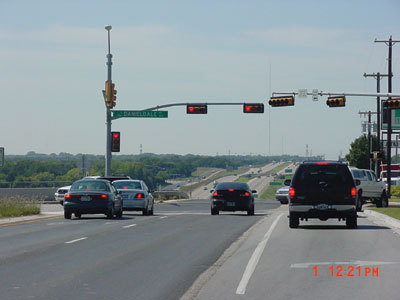CMAQ Cost: $62,00
Total Project Cost: $87,000
Not all effective mobility projects are large scale. Traffic congestion is often most keenly experienced in specific corridors, and small projects can be highly successful in generating localized timesavings and mobility benefits. The 14-mile section of Belt Line Road and Denton Tap Road in the cities of Irving and Coppell is a case in point. This roadway section included several locations where traffic congestion was a problem. For instance, an intersection along Denton Tap Road experienced heavy traffic during times of day when vehicles were approaching or departing the Coppell High School. The eastbound approach at this intersection had a dedicated left-turn lane and two through lanes, but no dedicated right-turn lane, so any through traffic using the outside right lane caused right-turning traffic to queue when eastbound traffic was stopped at the light. Another constant source of congestion was the traffic associated with the Irving Mall. The intersections around the mall are closely spaced, and the intersection of Belt Line Road with the westbound approach to the mall was congested on Saturday afternoons.
For these locations, Dallas County decided that retiming traffic signals would help to improve travel times, reduce delay, and improve air quality. Project 75 of the Dallas County CMAQ Program included 32 existing signalized intersections and two proposed signalized intersections along the 14-mile section of Belt Line Road and Denton Tap Road. Coordination between the cities of Irving and Coppell was required, as the Belt Line Road crosses between jurisdictions. As part of the project, initial traffic data were collected and analyzed to determine the existing signal timing characteristics, including phasing, cycle length and presence or absence of coordination. Based on this analysis, preliminary signal timing plans were developed for each of the proposed traffic control areas and time periods (morning peak, noon peak, afternoon off peak, evening peak, Saturday). Interval times and pedestrian clearance were taken into account in the development of the plans. The timing plans were then finalized and implemented with input from and coordination between the two cities. Finally, modifications were made to the signal timing based on observations of traffic flow and citizen input, and final travel time data were collected. In addition to the signal retiming, the project also involved making recommendations for hardware improvements and geometric improvements, some of which were implemented in order to further improve traffic flow in the corridor.

The retiming of the traffic signals along the Belt Line corridor has generated definite improvements to traffic flow, including reductions in the number of stops for vehicles and travel time along Belt Line Road, increases in average speed in both directions, and shorter stop-delay times. For example, in the evening peak hour in the southbound direction, the average vehicle experienced a more than 60-percent reduction in the number of stops, from 13.3 to 4.7 stops on average, across the 14-mile corridor. Under those conditions, average speeds increased from 29 to 39 miles per hour, and travel time dropped from more than 26 minutes to 19.5 minutes. In total, it is estimated that the project resulted in an annual travel time savings of nearly 3 million hours, an annual decrease of 42.4 million vehicular stops at traffic signals, and an annual decrease in total delay time of nearly 300,000 hours.19
Recommendations were also identified for hardware and pavement marking improvements to further enhance the effectiveness of the retimed traffic signals. Regarding the congested intersection near the Coppell High School, it was identified that right-turning eastbound traffic at the school intersection would be aided by the conversion of the outside through lane to a right-turn-only lane, allowing this traffic to turn on red. It was also recommended that congestion around the Irving Mall could be reduced by adding right-turn capacity to the road and installing a "right-turn overlap" phase that allows protected right turns when the northbound traffic is stopped.
1 kg/day VOC
Craig Goodroad
Dallas County CMAQ Office
214-747-6336
19 Sverdrup Civil, Inc. Dallas County CMAQ Program, Project 75: Irving and Coppell, Belt Line Road/Denton Tap Road.
Appendices. Performed for Dallas County, City of Coppell, City of Irving. February 18, 1998.